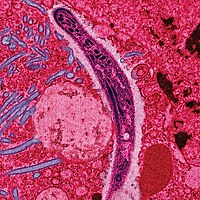
Photo from wikipedia
Objective To describe help seeking behaviour from a medical doctor and antimicrobial use for common infections among rural residents of Anhui province, China. Design A cross-sectional retrospective household survey. Setting… Click to show full abstract
Objective To describe help seeking behaviour from a medical doctor and antimicrobial use for common infections among rural residents of Anhui province, China. Design A cross-sectional retrospective household survey. Setting 12 administrative villages from rural Anhui, China. Participants 2760 rural residents selected through cluster-randomised sampling using an interviewer administered questionnaire. Method Logistic regression models were used to estimate associations between exposures (health insurance and antimicrobial-related knowledge), adjusted for confounders (sex, age and education), and help-seeking behaviour from a medical doctor and antimicrobial use following common infections, including acute respiratory tract infections (ARTIs), gastrointestinal tract infections (GTIs) and urinary tract infections (UTIs). Results In total 2611 (94.6%) rural residents completed the questionnaire. Help seeking from a medical doctor was highest for ARTIs (59.4%) followed by GTIs (42.1%), and UTIs (27.8%). Around two-thirds (82.3% for ARTIs, 87.0% for GTIs and 66.0% for UTIs) of respondents sought help within 3 days following symptom onset and over three quarters (88% for ARTIs, 98% for GTIs and 77% for UTIs) reported complete recovery within 7 days. Of the help-seeking respondents, 94.5% with ARTI symptoms recalled being prescribed either oral or intravenous antimicrobials (GTIs 81.7% and UTIs 70.4%). Use of antimicrobials bought from medicine shops without prescriptions ranged from 8.8% for GTIs to 17.2% for ARTIs; while use of antimicrobials leftover from previous illnesses or given by a relative ranged from 7.6% for UTIs to 13.4% for ARTIs. Multivariate logistic regression analysis revealed that respondents with a higher antimicrobial-related knowledge score and lack of insurance were associated with lower levels of help-seeking for ARTIs; while respondents with a higher antimicrobial-related knowledge score were less likely to be prescribed either oral or intravenous antimicrobials. Conclusions Excessive antimicrobial use in the studied primary care settings is still prevalent.
Journal Title: BMJ Open
Year Published: 2019
Link to full text (if available)
Share on Social Media: Sign Up to like & get
recommendations!